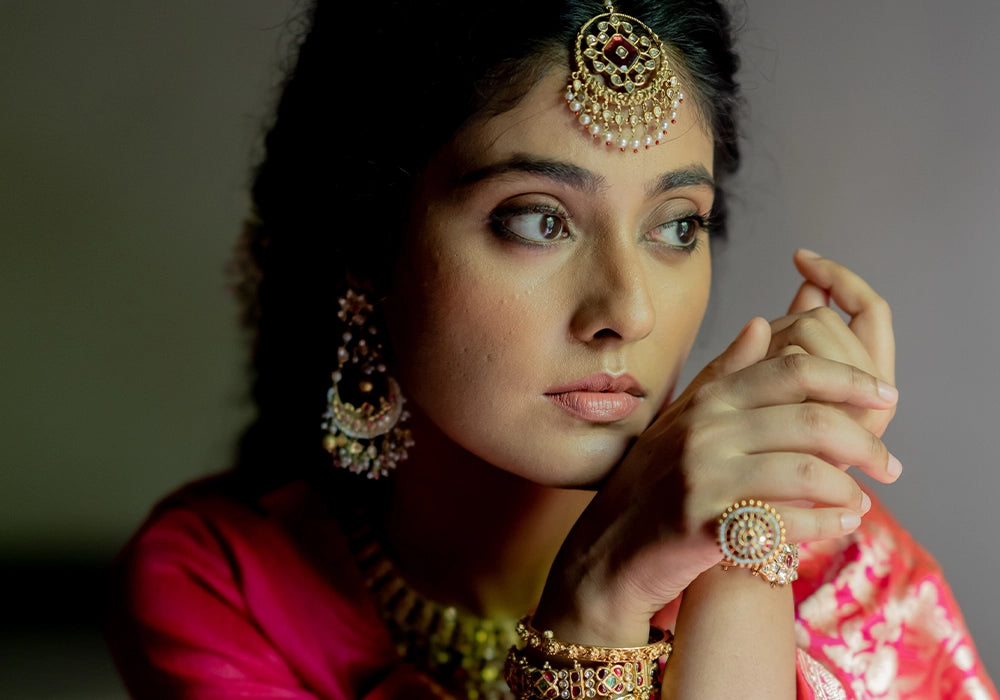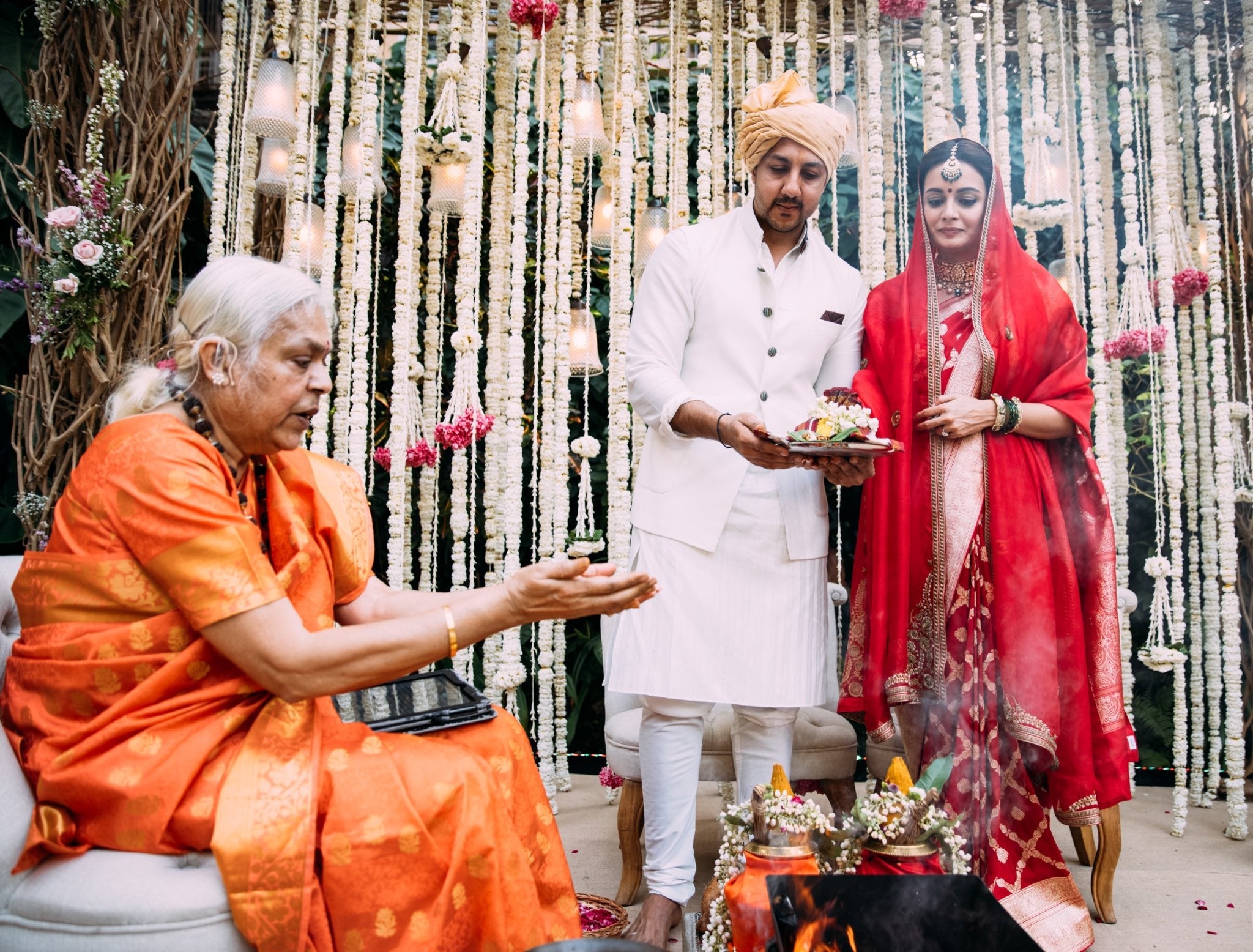The saree is not just an attire but an emotion that is woven stitch by stitch and row by row through generations, decorated with intricate designs and rich colors. Wearing a saree is rooted deep in the heritage of the country, which makes it an integral part of an Indian wedding. It is a piece of clothing that embodies the essence of Indian culture and traditions.

Padmini, the Lotus Lady; by Raja Ravi Varma
Image courtesy: Wikimedia Commons
Draping a saree is an art form symbolizing grace, beauty, and femininity, along with being a symbol of India's cultural diversity. It is a land where contrasts blend well, and each region honors its uniqueness in its own way. Diversity flows through the veins of the country, and the same can be seen in the way of draping a saree.
A Tapestry Of Traditions—Saree Draping Styles In Indian Weddings
Nivi: The Drape Said To Be From the Rice Bowl of India

Image courtesy: Pinterest
The most common and modern way of draping a saree that we see today has the Nivi drape as its foundation. Some scholars attribute Andhra Pradesh to be its place of origin, while others accredit Jnanadanandini Devi, the sister-in-law of Rabindranath Tagore to have developed this drape.
This drape is so popular that wearing a saree is often represented by it. The royal women of Andhra Pradesh preferred wearing sarees in Nivi drape as it showcased the design and flair of the saree in the best possible way. Even today, women can be seen wearing sarees in the Nivi drape at Indian weddings and other occasions like haldi, sangeet, and engagement.
The Nivi saree drape is wrapped around the lower body with 8–10 pleats in the front. The other side of the saree covers the upper body, and the pallu is pinned and left hanging down the shoulder. Some women also prefer keeping the pallu open. Either way, it looks beautiful and serene!
Nauvari: The Warriors Drape of the Great Marathas

Priyanka Chopra and Deepika Padukone donning the Nauravi drape in a still from the Bollywood period drama, Bajirao Mastani
Image courtesy: Pinterest
Maharashtrian saree drape uses a long nine-yard saree, the length after which it is named "Nauvari". It has pleats tucked at the back, with one end going from front to back between the legs, which gives it the look of a dhoti. We have all seen it work its charm on the actresses in the movie Bajirao Mastani.
Known for its unique dhoti-style drape, the Nauvari drape does not require a skirt to be worn under. The pallu of the saree flares elegantly behind, covering the upper body. This fun and elegant draping allows swift leg movements and is easy to handle. Just add in a traditional Maharashtrian nose pin named Peshwai Nath and a moon-shaped bindi to complete the look, and you will be good to go!
Athpourey or Atpoure Shari: The Graceful Drape From the Land of Cultures

Sharmila Tagore donning the Athpourey drape in a still from the classic Bollywood movie, Amar Prem
Image courtesy: Pinterest
Women in the west Bengal region prefer wearing a light handloom saree named Tant. Flowy and light, Tant saree designs usually have handprints on their borders and are very comfortable to wear on a daily basis. This characteristic has earned it the name Athpourey or Atpoure, which means “common wear”.
Athpourey stands out for its uniqueness. Unlike other draping styles, the Athpourey style has box pleats and a pallu on both shoulders. The left shoulder pallu is taken from behind and draped on the right shoulder, where it hangs free. Elegant and classic, Athpourey is widely celebrated in Bollywood movies. The iconic Dola re Dola song from the Bollywood masterpiece Devdas is a prime example showcasing the royalty of this drape paired with traditional vintage jewelry with a finishing touch of a big bright red bindi!
Mundum Neriyathum: An Ancient Drape From God’s Own Country

Image courtesy: Pinterest
Mundum Neriyathum drape stands out for its no-pallu look. It uses a traditional two-piece cream or white woven cotton saree from Kerala with a golden zari border known as Kasuvu or settu-mundu. The name of the drape simply refers to both garments: Mundum refers to the lower garment, and Neriyathum refers to the upper garment. Though the drape differs from the standard draping style we are accustomed to, this iconic drape is one of the ancients.
Also known as the half saree style, this has two separate sarees draped elegantly in such a way that they effortlessly showcase the classic golden border. The mundu is draped around the waist and pleated like a normal saree. The other part, Neriyathum, is wrapped across the upper body diagonally and pleated over the left shoulder. Often showcased in a very graceful way in folk dances, ancient jewelry enhances the beauty of Mundum Neriyathum!
Mekhela Chadar: The Delicate Drape From “Blue Hills and Red River”

Image courtesy: Pinterest
Mekhela chadar is a popular saree draping style from Assam. It got its name from a traditional saree of the same name, as this style consists of draping only this particular saree. Very similar to Mundum Neriyathum, Mekhela Chadar also comprises two pieces. Here, Mekhela is the lower part, and Chadar is the upper part.
The bottom half, or mekhela, is draped around the lower body with pleats like a normal saree. The pleats are fewer and are tucked higher than the normal drape, which gives it a unique look. The upper half, the chadar, is tucked very close to the pleats and draped around the shoulder like a shawl. Weddings in Assam are incomplete without this traditional wedding dress passed down from generations!
Seedha Pallu: A Classic Drape From “The Jewel of Western India”

Nita Ambani donning the Seedha Pallu drape for her wedding.
Image courtesy: Bollywoodshaadis
Traditionally worn by Gujarati women, the Seedha pallu drape is a popular draping style in Indian weddings. In this saree draping style, the pallu comes from back to front. Pallu is taken from the back of the right shoulder and spread across till it reaches the back of the blouse, where it is pinned. Instead of hanging behind, the pallu sits gracefully on the front, which has given this style its name—Seedha means straight pallu.
It is comfortable for hand movement and gives a huge playground to display intricate works of pallu, and as you don't have to carry the pallu on your back, it doesn't feel heavy. The curvy flow of the pallu looks graceful and gives away the look of a lehenga; hence, this draping style is famous in other regions as well.
Gol Saree: The Pride of Parsis

Image courtesy: Zoriastrians.net
The Parsi community wears sarees with vibrant colors and beautiful designs. Their traditional way of draping a saree is quite similar to Gujarat's Seedha pallu, with minor changes. It is a brilliant way to display the work of the saree. Gol means round, the drape goes elegantly from front to back, giving it its name.
One end of the saree is wrapped around the waist with pleats in the center, and the other end (pallu) comes from the back to the front. The pallu is pleated and pinned on the right shoulder. They keep their pallu quite long, so when it is spread to cover the body, it falls quite close to the hem of the saree. The pallu is pinned to the back of the left shoulder, giving a large playground to display the intricacy of the designs. Indian weddings in the Parsi community are incomplete without spotting a bright georgette saree worn in the traditional Gol drape paired with vintage pearl jewelry!
Madisaru: Drape From “The Land of Temples”

Image courtesy: Pinterest
Wearing the Madisaru drape is an essential part of south Indian wedding traditions. Here, the lower half is worn like a dhoti while the upper half is pleated like a normal saree, with a pallu hanging below the shoulder, similar to the Nauvari drape. Traditionally, a nine-yard Kanjeevaram saree is draped in Madisaru by women after their marriage.
Saree truly is a vital part of Indian heritage, and with various draping styles, each region celebrates its individuality along with the diversity of the culture. A visual treat of the Indian wedding lookbook—a humble and graceful saree draped in any way looks royal!








